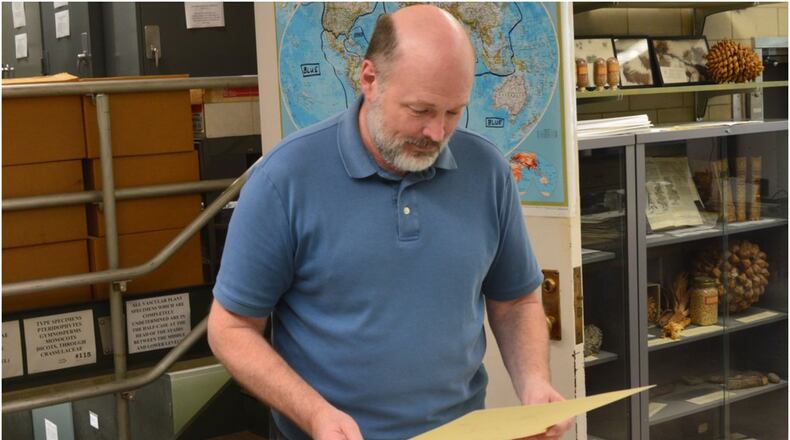“When we went on vacations, I would see an unusual plant by the road and have to stop. The kids would roll their eyes and I’d tell them I had to stop to see what it is,” he said. “There are so many plant species in the world, you have to focus. I love to travel because I get to look at plants.”
He has been on the Miami University botany staff 34 years, the past 24 years as curator of the herbarium, housing 650,000 specimens from around the world and often a go-to source for researchers.
The original herbarium opened at Miami in the 1870s and was closed for a few years before reopening in 1906. Bruce Fink was the first curator and the first chair of botany and bacteriology at Miami. Vincent was preceded by Hardy Eshbaugh, who spent many years as curator.
Vincent’s father had taken a botany class from Tom Cobbe, who taught general botany classes at the university and that interest got passed down.
“At 5 years old, I started collecting plants,” he said. Now he oversees a collection he describes as including “all groups of organisms botanists study and even some fossil plants.”
The collection is housed in three floors of cabinets in the south lower levels of Upham Hall with many boxes of donated specimens still waiting to be catalogued and filed. With a nod to modern technology, Vincent said they have “a statistically very valuable collection” and are in the process of putting it into a data base to make the plants available to researchers on-line.
“The internet has really changed the way I do my work,” he said. “There is so much more information.”
That is a long-term project with an estimated 650,000 items in the collection.
Items date back to the 1790s and have come from all over the world. Many of them came from other collections and some were purchased. Oberlin College, for example, decided in the 1960s to get rid of their collection and Miami bought it, bringing in several hundred thousand items.
“It took well into the 90s to deal with that,” he said.
His predecessor, Eshbaugh, contributed his pepper collection gathered in a lifetime of collecting, prompting Vincent to note, “That’s a really valuable collection, scientifically.”
His own special area of botanical interest is trifolium—clovers—and he has contributed to the herbarium collection in that area but he gets as excited about his students’ work in the field as his own. He tells of one student who shared his interest in clovers and who discovered a previously-unclassified specimen growing in central Kentucky. As the finder, she was given the privilege of actually naming it.
“It is a pretty neat plant,” he said. “I try to give students research projects like that. It gives them a boost and love for what they are doing.”
With a large collection and many boxes of materials as yet unopened, Vincent said he is able to indulge some of his other interests becoming something of a detective trying to backtrack the history of items when he opens one of those boxes.
“It’s fun to do sleuthing, how it got here,” he said. “I love history. It brings me joy.”
One big find last year came from such a box which had been awaiting inspection. He said he opened it to find several binders of algae specimens collected by Carolyn Bingham, who died in 1932. Her collection had been considered lost for the last 85 years and it turned up in a box of items waiting to be catalogued and filed in Miami’s herbarium.
Women of the Victorian era were a prolific source of plant specimens, Vincent said.
“Books have been written about those Victorian-era women. This was just a lady out traveling, the first to get to these areas because they had the money,” he said.
One such woman was Mary Fisk Spencer, who traveled and sent back 65,000 samples, all sewed onto pieces of paper.
Samples in those three floors of cabinets in Upham Hall are in color-coded files, based on evolutionary schemes of plants in the areas of the world where they are found. One room off of those cabinets has a drying press used to dry out samples prior to mounting. In some cases, researchers in other parts of the world inquire about certain items and the herbarium curator explains they can collect items and dry them to send them out. Others already in the collection can be loaned out on request.
The growth of their internet database is having a dual effect on the collection, need for information, but more for the actual samples.
“Requests coming in are fewer with the information available on the internet,” Vincent said. “The number of requests (for actual samples) have gone up because of the internet.”
Vincent grew up in Versailles, Ohio and earned his Ph.D. at Miami and “never left.” His wife of 37 years, the former Mary White, is the daughter of retired Talawanda district administrator Dr. Ernest White.
There is only one display case, in the hallway, but with well over a half-million plant specimens it is a collection threatening to overrun the available space. Vincent keeps the herbarium true to its original vision.
“It’s more research than museum. There’s not much room for displays. The way the herbarium developed is a research facility to use as a teaching tool and research,” he said. “We are constantly getting more things in. It’s not just a plant. There is so much exploration going on in the world and we have bits and pieces of it here.”
About the Author
